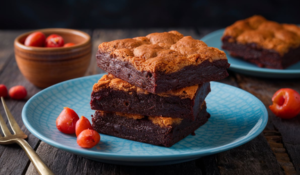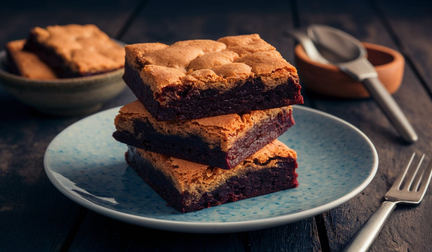Introduction
If you love sweet treats, you’ve probably enjoyed both Difference Between a Brownie and a Biscuit . But have you ever wondered what sets these two apart? Although both are delicious, they differ in many ways. From ingredients and texture to origins and cultural significance, brownies and biscuits have their own unique identities. This article will explore the key differences between brownies and biscuits, helping you appreciate what makes each one special.
A Brief History: Brownies vs. Biscuits
Understanding the origins of these treats provides context for their differences.
Brownies originated in the United States in the late 19th century. One popular story credits a Maine housewife who forgot to add baking powder to her cake batter. This mistake created the first dense, fudgy brownie. Another tale suggests a chef at Chicago’s Palmer House Hotel created brownies for the 1893 World’s Columbian Exposition. Regardless of the true origin, brownies quickly became a staple in American kitchens.
Biscuits have a much older history. In the United Kingdom, biscuits refer to what Americans call cookies – crisp, sweet, and perfect with tea. However, in the United States, biscuits are soft, flaky, and often served with savory dishes. The word “biscuit” comes from the Latin bis coctus, meaning “twice baked,” reflecting the early methods used to make them. Ancient Roman soldiers carried hardtack-like biscuits for sustenance. Over time, these evolved into the sweet and savory varieties we enjoy today.
Ingredients: What Goes Into a Brownie vs. a Biscuit?
The ingredients define the fundamental differences between brownies and biscuits.
Brownies typically include butter, sugar, eggs, flour, cocoa powder, and chocolate. Some recipes add nuts, vanilla, or coffee for enhanced flavor. The combination of butter, sugar, and chocolate gives brownies their rich, dense texture. Unlike cakes, brownies usually do not contain leavening agents like baking powder, which keeps them dense and fudgy.
Biscuits in the American sense are made with flour, butter or shortening, baking powder or soda, and buttermilk or milk. The dough is rolled out and cut into shapes before baking. The result is a soft, flaky bread. In the UK, biscuits are made with flour, sugar, butter, and sometimes eggs, resulting in a crisp, cookie-like treat.
Texture and Consistency: The Key Differences
Texture is one of the most noticeable differences between brownies and biscuits.
Brownies are dense, fudgy, and chewy. They often have a soft, gooey center with a slightly crisp top. Some prefer cakey brownies, which are lighter, while others enjoy ultra-fudgy brownies. The butter and chocolate contribute to the rich texture, making brownies an indulgent treat.
Biscuits in the American sense are light and flaky, with layers that peel apart easily. This texture is achieved by cutting cold butter into the flour, creating fat pockets that melt and form layers during baking. In contrast, UK biscuits are crisp and crunchy, with a firm texture that holds up well when dunked in tea.
Flavor Profiles: How Do They Compare?
While both are sweet, brownies and biscuits offer distinct flavor profiles.
Brownies have a dominant chocolate flavor, thanks to the cocoa powder and chocolate. Some recipes produce intensely rich brownies, while others have a milder sweetness with hints of vanilla or coffee. Butter adds a rich flavor, making brownies a satisfying dessert.
Biscuits in the American style have a mild, buttery taste with a slight tang from the buttermilk. They are less sweet than brownies and can be savory or sweet, depending on how they are served. UK biscuits are typically sweeter and come in various flavors, from plain shortbread to spiced varieties, making them a perfect tea-time treat.
Serving Suggestions and Pairings
Brownies and biscuits are served and enjoyed differently.
Brownies are often served as a dessert or snack. They are delicious on their own or paired with vanilla ice cream or whipped cream. Some people drizzle them with caramel or chocolate sauce or sprinkle them with powdered sugar. Brownies are also popular at potlucks and bake sales because they are easy to transport and share.
Biscuits in America are versatile and can be served with various meals. They are often enjoyed as a side dish with savory meals like fried chicken or topped with butter and jam for breakfast. Biscuits and gravy, a Southern staple, features biscuits smothered in rich sausage gravy. UK biscuits are typically enjoyed as a snack or with tea, either plain or with jam, cream, or chocolate. They are a key part of afternoon tea, a traditional British meal that includes sandwiches, scones, and pastries.
Variations and Regional Differences
Both brownies and biscuits have many regional variations, reflecting their adaptability.
Brownies can vary widely. Blondies, for example, use brown sugar and vanilla instead of chocolate, giving them a butterscotch-like flavor. Some recipes add nuts, chocolate chips, or cream cheese for extra richness. Preparation methods also vary – some melt the chocolate and butter together, while others cream the butter and sugar first.
Biscuits in America vary by region. Southern biscuits are fluffier due to soft wheat flour, while Northern biscuits are denser. UK biscuits come in countless varieties, from shortbread to ginger snaps. Each region may have its specialty, often passed down through generations.
Cultural Significance and Traditions
Brownies and biscuits hold special places in their respective cultures, with unique traditions attached to each.
Brownies are a symbol of home baking and comfort in the United States. Many Americans have fond memories of making brownies with family, using beloved recipes or popular boxed mixes. Brownies are a common treat for school events, bake sales, and holidays, making them a staple of American dessert culture.
Biscuits in the United States are a traditional part of Southern cuisine, associated with comfort food and hospitality. Southern families often have cherished biscuit recipes, and making biscuits from scratch is a sign of culinary skill. In the UK, biscuits are an integral part of daily life, often enjoyed with tea during “elevenses” or afternoon tea. The tradition of afternoon tea, dating back to the 19th century, has helped cement the biscuit’s place in British culture.

Baking Techniques: What Sets Them Apart?
The techniques for making brownies and biscuits contribute to their unique textures and flavors.
Brownies require careful mixing to avoid over-aeration, which can lead to a cake-like texture. Chocolate and butter are usually melted together before being mixed with sugar, eggs, and flour. The batter is then poured into a baking pan and baked until the edges are set but the center remains slightly soft.
Biscuits require a light touch to ensure tenderness and flakiness. The key is to keep the butter cold and handle the dough as little as possible. This ensures the fat doesn’t melt before baking, creating layers in the biscuit. In contrast, UK biscuits involve creaming butter and sugar together before adding flour and other ingredients. The dough is rolled out, cut into shapes, and baked until crisp.
Nutritional Differences: Brownies vs. Biscuits
The nutritional content of Difference Between a Brownie and a Biscuit varies, reflecting their ingredients and serving sizes.
Brownies are generally higher in calories and fat due to their rich ingredients like butter, chocolate, and sugar. A single brownie can contain 150 to 300 calories, depending on its size and the recipe. Brownies are also high in sugar, contributing to their sweetness and chewy texture.
Biscuits in America are lower in sugar but still high in calories due to the butter or shortening used in the dough. A single biscuit might contain 150 to 250 calories. UK biscuits vary widely in nutritional content, with plain shortbread higher in fat and others, like digestive biscuits, having more fiber.
Healthier Alternatives: Can You Make Them Better for You?
If you want to enjoy brownies or biscuits with less guilt, there are healthier alternatives.
Brownies can be made healthier by reducing sugar or using natural sweeteners like honey or maple syrup. Substituting some butter with applesauce or Greek yogurt lowers fat content while keeping brownies moist. Adding whole wheat flour or ground flaxseed boosts nutrition.
Biscuits can be healthier by using whole wheat flour or a mix of flours. Reducing butter or shortening and using Greek yogurt or cottage cheese as substitutes also lowers fat content. UK biscuits can be made healthier by reducing sugar, using natural sweeteners, or adding oats or nuts for extra fiber.
Conclusion: The Sweet Truth About Brownies and Biscuits
In summary, Difference Between a Brownie and a Biscuit are distinct in almost every way. Brownies are rich, dense, and chocolatey, making them perfect for satisfying a sweet craving. Biscuits, whether American or British, are more versatile, offering various flavors and textures that can be enjoyed at any time of day.
By understanding the Difference Between a Brownie and a Biscuit , you can better appreciate what makes each one unique. Whether you prefer the indulgent experience of a brownie or the comforting taste of a biscuit, both treats hold a special place in the world of baking.

